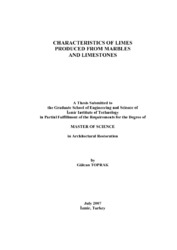Please use this identifier to cite or link to this item:
https://hdl.handle.net/11147/3833| Title: | Characteristics of Limes Produced From Marbles and Limestiones | Authors: | Toprak, Gülcan | Advisors: | Böke, Hasan | Publisher: | Izmir Institute of Technology Izmir Institute of Technology |
Abstract: | In this study, characteristics of lime produced from some marbles and limestones were investigated in order to compare their effects on the lime mortars. For this purpose, limestones that contain low and high amounts of diatoms and marbles quarried from the city of Muğla and the Marmara island were selected as samples. The calcination temperatures of the stones were found to be around 800 C by TGA analysis. Considering their calcination temperatures, they were heated to 850 C in a laboratory furnace, then slaked and carbonated. Before and after these processes, mineralogical and chemical compositions, and microstructures of the products were investigated by XRD and SEM-EDS analysis. The hydraulic properties of carbonated limes were evaluated by determining weight loss at the temperatures between 200-600 C due to the loss of the structurally bound water of hydraulic products and weight loss at the temperatures over 600 C due to carbon dioxide released during the decomposition of calcium carbonates by TGA. The effects of limes on the properties of mortars were investigated by producing lime mortars and comparing their compressive strengths during one year carbonation in laboratory condition. Mortars were prepared with one part (in weight) of lime and three parts (in weight) of marble aggregates. The results of the study indicated that the lime produced from limestone containing high amounts of diatoms is highly hydraulic due to formation of calcium silicate whereas the others are non-hydraulic. The mortars prepared from lime containing high amounts of diatoms were found to be relatively high in compressive strength due to its hydraulicity. The results show that the production of hydaulic lime composed mainly of calcium silicate at a relatively low calcinations temperature (850 C) is possible. Considering this result, it can be concluded that hydraulic lime could be produced by the calcining of limestone containing diatoms in historic kilns. | Description: | Thesis (Master)--Izmir Institute of Technology, Architectural Restoration, Izmir, 2007 Includes bibliographical references (leaves: 74-77) Text in English; Abstract: Turkish and English xii, 77 leaves |
URI: | http://hdl.handle.net/11147/3833 |
| Appears in Collections: | Master Degree / Yüksek Lisans Tezleri |
Files in This Item:
| File | Description | Size | Format | |
|---|---|---|---|---|
| T000624.pdf | MasterThesis | 9.78 MB | Adobe PDF |  View/Open |
CORE Recommender
Page view(s)
352
checked on Mar 31, 2025
Download(s)
126
checked on Mar 31, 2025
Google ScholarTM
Check
Items in GCRIS Repository are protected by copyright, with all rights reserved, unless otherwise indicated.